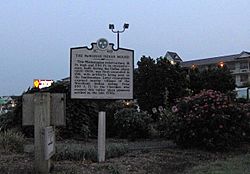McMahan Mound Site facts for kids

Tennessee Historical Commission sign marking the site of the McMahan Mound
|
|
| Location | Sevierville, Tennessee, Sevier County, Tennessee, |
|---|---|
| Region | Sevier County, Tennessee |
| Coordinates | 35°51′49.93″N 83°34′3.9″W / 35.8638694°N 83.567750°W |
| History | |
| Founded | 1200 CE |
| Abandoned | 1500 CE |
| Periods | Dallas Phase |
| Cultures | South Appalachian Mississippian culture |
| Site notes | |
| Excavation dates | 1881 |
| Archaeologists | William H. Holmes |
| Architecture | |
| Architectural styles | platform mound |
| Architectural details | Number of temples: 1 |
The McMahan Mound Site (also known as McMahan Indian Mound) is an ancient place where people once lived. It is located in Sevierville, Tennessee, right where two rivers, the West Fork and the Little Pigeon, meet. This site is like a historical puzzle piece, telling us about the people who lived there long ago.
Contents
What is the McMahan Mound Site?
This site has a large platform mound. A platform mound is a raised area of earth, like a big, flat-topped hill. It was probably used for important buildings or ceremonies. This mound is about 16 feet (5 meters) high and 240 feet (73 meters) wide.
Around the mound, there was a big village. This village was protected by a palisade, which is a strong fence made of tall wooden posts.
Who lived there?
People from the Mississippian culture lived at the McMahan Mound Site. Specifically, they were part of a group called the Dallas Phase. They lived here between the years 1200 and 1500 CE (Common Era).
When scientists first studied this ancient mound in 1881, it was on a farm owned by the McMahan family. That's why the mound is named after them!
Discoveries from Excavations
In 1881, a scientist named William Henry Holmes led a team to dig at the site. This kind of digging to find old things is called an excavation. They found many interesting items that tell us about the people who lived there.
What did they find?
The team found several things, including:
- Graves where people were buried.
- Arrowheads, which were used for hunting.
- A pipe made of marble.
- Pieces of Mississippian culture pottery, which are pots and dishes made by the Mississippian people.
- Many engraved shell gorgets and other shell ornaments. A gorget is a decorative piece, often worn around the neck or on the chest.
They also found some items that were made in Europe, like brass pins and glass beads. This was a big discovery! It showed that people were still living at the McMahan Mound Site when Europeans first started exploring the American Southeast. This means the site was active during a very important time in history.
Special Shell Gorgets
One of the most exciting finds was a broken shell gorget. It showed two "Birdmen." These Birdmen had wings and talons (like a bird's claws) instead of feet. They were holding each other by the neck with one hand and holding special stone knives with the other. This type of carving is known as the Hightower style.
Holmes also found other interesting gorgets:
- Some showed rattlesnakes. These are called the Lick Creek style and Citico style.
- Others looked like masks, known as the Chickamauga style.
- One gorget had looping lines that were very hard to understand. Holmes said it was a "very interesting object." This style is now called Williams Island or Spaghetti style.
These amazing finds help us understand the art, beliefs, and daily lives of the Mississippian people who lived at the McMahan Mound Site centuries ago.



